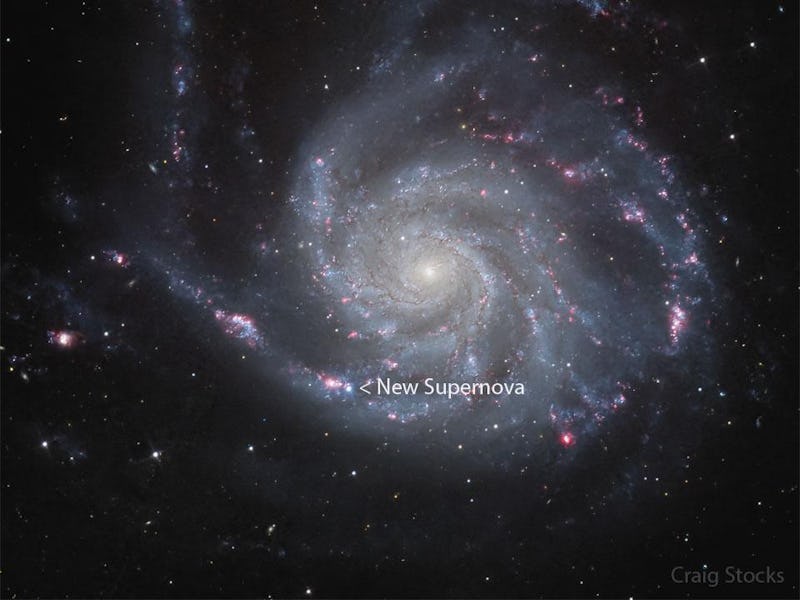A Star in a Nearby Galaxy Just Went Supernova — and You Might Be Able to See It
It's the closest look we're likely to get at such powerful cosmic mayhem.

We’ll probably never get to see Betelgeuse explode, but this could be the next best thing.
Telescopes around the world are watching the aftermath of a giant star’s explosive death in the nearby Pinwheel Galaxy, watching how the blazing cloud of stellar debris evolves in the days immediately after the cataclysm. The supernova is all that’s left of a giant star about 15 times more massive than our Sun. Now it’s nothing but cosmic smithereens — an expanding cloud of hot gas, seeding the surrounding space with heavy elements.
The supernova appears as a bright, starlike point of light on a spiral arm of the Pinwheel Galaxy, also known as M101, about 21 million light years away from Earth.
Astronomer Koichi Itagaki was the first to spot the bright flare of light in one of the Pinwheel Galaxy’s graceful spiral arms on May 19, about two days after the star actually exploded. Once Itagaki had alerted astronomers around the world, it turned out that the Zwicky Transient Facility, a sky survey designed to watch for exactly this kind of sudden cosmic event, had captured the beginnings of the supernova in automated images on May 17 — but no one noticed until Itagaki, two days later.
Now, telescopes in orbit and on the ground are paying very close attention to the supernova, measuring it in every wavelength of light from infrared to gamma rays. To catch your own glimpse of the supernova before it fades from view a few months from now, look between the last two stars in the handle of the Big Dipper. It’s not visible to the unaided eye, but even a relatively small telescope should be able to spot the supernova as a bright point of light in the sky.
What Happened?
The supernova will stay this bright for months before slowly fading from view, at least in the wavelengths of light our eyes can see. It will be visible in other wavelengths for much longer.
About 21 million years ago, a giant star in the Pinwheel Galaxy fused the last of its silicon into iron. For tens of millions of years, nuclear fusion deep in the star’s core had generated tremendous energy, and that energy kept the star from collapsing under its own gargantuan weight. When the star ran out of fuel, the energy that had kept it inflated suddenly cut off, and the star collapsed. The collapse triggered an enormous explosion, blasting the star’s outer layers out into space.
And 21 million years later, on May 17, 2023, the light of that final blast reached Earth. This supernova is a deeply ancient event, but to us, it looks very recent.
Based on the star’s mass, the ruins of its core — once one of the most massive, powerful nuclear reactors in the universe — probably collapsed into a small black hole, although it’s also possible that it left behind a dense ball of neutrons called a neutron star. Further observations will probably shed more light on exactly what the dead star left behind.
Astronomers around the world hope that studying the new supernova, poetically dubbed SN 2023ixf, will shed some light on the process of a star’s demise and what happens in the immediate aftermath.